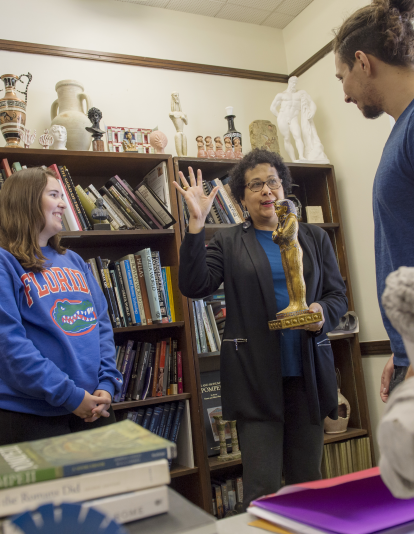Classical Archaeologist
“People think of archaeology as going out and digging, but that’s a small part of it,” says classics professor and chair Mary Ann Eaverly. “Once things are dug up, someone has to figure them out.”
Eaverly, who also has background in art history, has spent a lifetime figuring out the intentions of early Greek, Egyptian, and Roman sculptures, friezes, frescoes, and other artworks. “I do my digging in museums and libraries,” she says.

“When the Philadelphia Eagleswon the Superbowl, the parade they had reminded me so much of the Roman triumph.”
Her main focus is early Greek free-standing statues from the sixth BCE. She is comparing them with the frieze of the Parthenon. She sees similarities in the features of both and proposes that there is a continuity between the sixth- and fifth-century art, whereas other scholars see clear distinctions among the Archaic, Classical, and Hellenistic periods of Greek art. “I’m trying to make a connection between things that are standing still and things that are moving,” she says. “I want to study them in more of an art-historical way — how the form of the statues relates to function. I’m more interested in the why of it.”
For her latest book, Tan Men/Pale Women, Eaverly examined another aspect of statues: color. “In America, anything that has to do with color is about race, but in the Greek and Egyptian world, it has to do with the separation of the spheres of activity of men and women. You want to visually mark that they are different,” she says. “Men are dark and women are light. Men have outdoor lives, and women lead indoor household centered lives.”
Growing up, Eaverly was immersed in the classics. Her great-grandfather was a classics professor at a Historically Black College that no longer exists. He had a great influence on her father who passed his love of Latin, Greek, and the study of ancient cultures on to her. “We always had books about Tutankhamun in our house,” she says.
The modern world intrigues her as much as the ancient world. She co-teaches a class called the Impact of Materials in Society, a collaborative project with the College of Engineering. “The fabulous thing about UF is that you have opportunities like this,” she says, “to connect STEM and the humanities, to link a material to cultural significance.” She teaches the ways Romans used concrete.
“I also love pro football,” she says. “I was so excited when the Philadelphia Eagles won the Superbowl. “The parade they had reminded me so much of the Roman triumph.”
To support the people, program, or research featured in this story, please visit